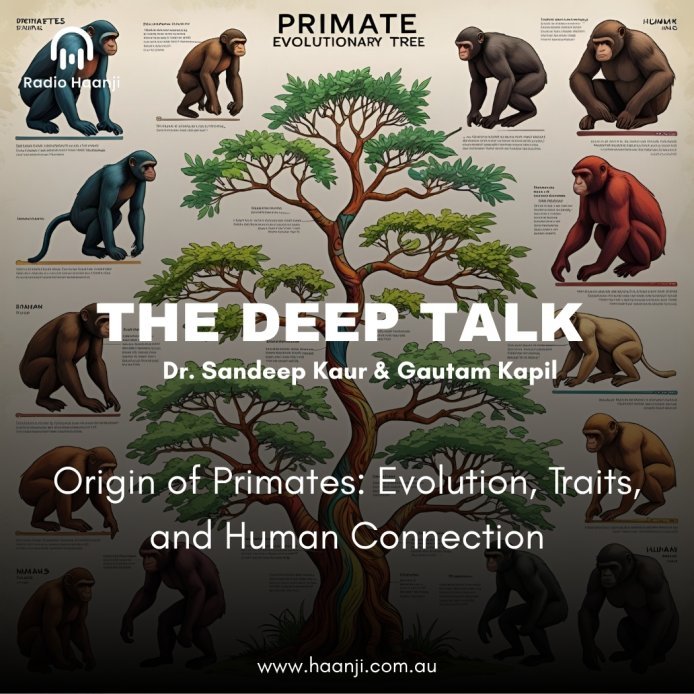
Origin of Primates: Evolution, Traits, and Human Connection
Host:-
 Dr. Sandeep Kaur
Dr. Sandeep Kaur
 Gautam Kapil
Gautam Kapil
Explore the origin of primates, their evolutionary traits, and human connections. Learn how these insights inspire space exploration!
Ever wondered where humans came from? The origin of primates reveals a fascinating journey through millions of years of evolution, connecting us to our closest relatives in the animal kingdom.
For space exploration enthusiasts, understanding the origin of primates: evolution, traits, and human connection offers a unique perspective on life’s adaptability, mirroring the resilience needed to explore the cosmos. This article dives into the evolutionary history of primates, their defining traits, and how they link to humans, providing insights that resonate with anyone curious about life’s beginnings.
What Is the Origin of Primates?
Primates, the order that includes humans, monkeys, and apes, emerged around 85 million years ago during the Late Cretaceous period. Molecular evidence suggests their divergence from other mammals began in the Paleocene, with the earliest fossils dated to 55 million years ago. These early primates, like plesiadapiforms, were small, arboreal mammals adapting to tree-dwelling life in Eurasia and North America. Their evolution was shaped by environmental shifts, such as the spread of flowering plants and warmer climates, which opened new ecological niches.
The fossil record is sparse, but key finds like Darwinius (47 million years old) from the Eocene show early primates with traits like forward-facing eyes and grasping hands. These adaptations set the stage for the diversity of modern primates, from lemurs to humans.
What Are the Key Traits of Primates?
Why Did Primates Evolve Unique Traits?
Primates stand out from other mammals due to specific traits that evolved to support their arboreal lifestyle and social behaviors. These characteristics not only helped them survive but also laid the groundwork for human evolution:
-
Forward-Facing Eyes: Primates developed stereoscopic vision for depth perception, crucial for navigating trees. This trait enhances precision, much like astronauts need for space missions.
-
Grasping Hands and Feet: Opposable thumbs and big toes allowed primates to grip branches and manipulate objects, a precursor to human tool use.
-
Large Brains: Primates have larger brains relative to body size compared to other mammals, enabling complex problem-solving and social interactions.
-
Reduced Snouts: Smaller muzzles and versatile teeth adapted to varied diets, from fruits to leaves, reflecting dietary flexibility.
-
Social Structures: Many primates live in complex social groups, fostering behaviors like cooperation and communication, which echo human societies.
These traits evolved through natural selection, driven by environmental challenges like forest navigation and resource competition. For space enthusiasts, these adaptations highlight life’s ability to thrive in extreme environments, akin to surviving in space.
How Do Primate Traits Connect to Humans?
Humans share a common ancestor with chimpanzees and bonobos, dating back 6-8 million years. Traits like bipedalism, large brains, and tool use distinguish humans but have roots in primate evolution. For example:
-
Bipedalism: Evolved over 4 million years ago in hominins like Australopithecus, freeing hands for tool-making, similar to how astronauts use tools in zero gravity.
-
Brain Size: Human brains (1350 cc) are significantly larger than those of great apes (400-600 cc), supporting advanced cognition and language.
-
Social Complexity: Primate social bonds, seen in chimpanzees’ tool use and bonobos’ cooperative behaviors, mirror human collaboration in space missions.
These connections show how primate traits evolved into human capabilities, offering insights into adaptability for extraterrestrial exploration.
How Did Primates Evolve Over Time?
What Is the Timeline of Primate Evolution?
The evolutionary journey of primates spans millions of years, marked by key milestones:
-
Late Cretaceous (~85 mya): Primates diverged from other mammals, likely as small, tree-dwelling creatures.
-
Paleocene (~55 mya): Earliest primate fossils, like plesiadapiforms, appear in North America and Eurasia.
-
Eocene (~47 mya): Adapiforms and omomyids, early true primates, show advanced traits like stereoscopic vision.
-
Oligocene (~35 mya): Anthropoids (monkeys and apes) emerge in Africa and Asia, with fossils like Aegyptopithecus.
-
Miocene (~15-5 mya): Hominids diverge from gibbons, and later, hominins (human ancestors) split from chimpanzees.
-
Pliocene-Pleistocene (~5.3 mya-200 kya): Hominins like Homo erectus and Homo sapiens develop bipedalism, tool use, and larger brains.
This timeline reflects how environmental changes, like cooling climates and forest reduction, drove primate diversification.
How Does Primate Evolution Compare to Other Mammals?
Primates face competition from other mammals, but their unique adaptations gave them an edge. Here’s a comparison:
|
Trait |
Primates |
Other Mammals (e.g., Rodents) |
Advantage |
|---|---|---|---|
|
Vision |
Stereoscopic, forward-facing eyes |
Often side-facing eyes |
Better depth perception for arboreal life |
|
Brain Size |
Large relative to body (e.g., 2% in humans) |
Smaller (e.g., 0.5% in rats) |
Enhanced cognition and problem-solving |
|
Limbs |
Grasping hands and feet |
Claws or hooves |
Improved manipulation and climbing |
|
Social Behavior |
Complex social groups |
Often solitary or less complex |
Cooperation for survival |
Primates’ arboreal adaptations allowed them to exploit tree-based resources, while rodents dominated ground-based niches. This specialization reduced direct competition but required primates to adapt to changing forests, much like spacecraft must adapt to new environments.
The Human Connection: Why It Matters for Space Enthusiasts
For those fascinated by space exploration, the origin of primates offers a lens to understand life’s adaptability. Primates’ ability to develop complex tools and social structures mirrors the teamwork and innovation needed for space missions. For instance, chimpanzees’ use of sticks for termite fishing parallels astronauts’ use of specialized tools. The evolution of large brains and problem-solving skills in primates suggests life can adapt to extreme conditions, a key consideration for finding life on other planets.
Moreover, 60% of primate species face extinction due to habitat loss, highlighting the need for conservation efforts akin to protecting extraterrestrial environments. Understanding our primate roots can inspire sustainable practices for future space colonies.
Current Trends in Primate Evolution Research
Recent studies focus on genetic and fossil evidence to clarify primate origins. Ancient DNA analysis and new fossils, like Nakalipithecus (10 mya), help trace the human-chimp split. Social media platforms like X note trending discussions on “human evolution” and “primate intelligence,” reflecting public interest. These trends align with space enthusiasts’ curiosity about life’s origins and adaptability.
FAQs About the Origin of Primates
When Did Primates First Evolve?
Primates diverged from other mammals around 85 million years ago in the Late Cretaceous, with the earliest fossils appearing 55 million years ago in the Paleocene.
How Are Humans Connected to Primates?
Humans share a common ancestor with chimpanzees and bonobos from 6-8 million years ago, evolving traits like bipedalism and larger brains from primate foundations.
Why Are Primate Traits Important for Space Exploration?
Primates’ problem-solving, tool use, and social cooperation mirror skills needed for space missions, offering insights into life’s adaptability in extreme environments.
Conclusion: Connecting Primates to Our Cosmic Future
The origin of primates: evolution, traits, and human connection reveals a story of adaptation and resilience, from tree-dwelling ancestors to modern humans exploring the stars. By understanding how primates evolved traits like large brains and social bonds, space enthusiasts can draw parallels to the ingenuity required for cosmic exploration. With 60% of primate species at risk, preserving their habitats is as crucial as protecting potential extraterrestrial ecosystems.
What fascinates you most about our primate origins? Share your thoughts in the comments and explore how these evolutionary lessons can shape our journey to the stars!
What's Your Reaction?
































































































